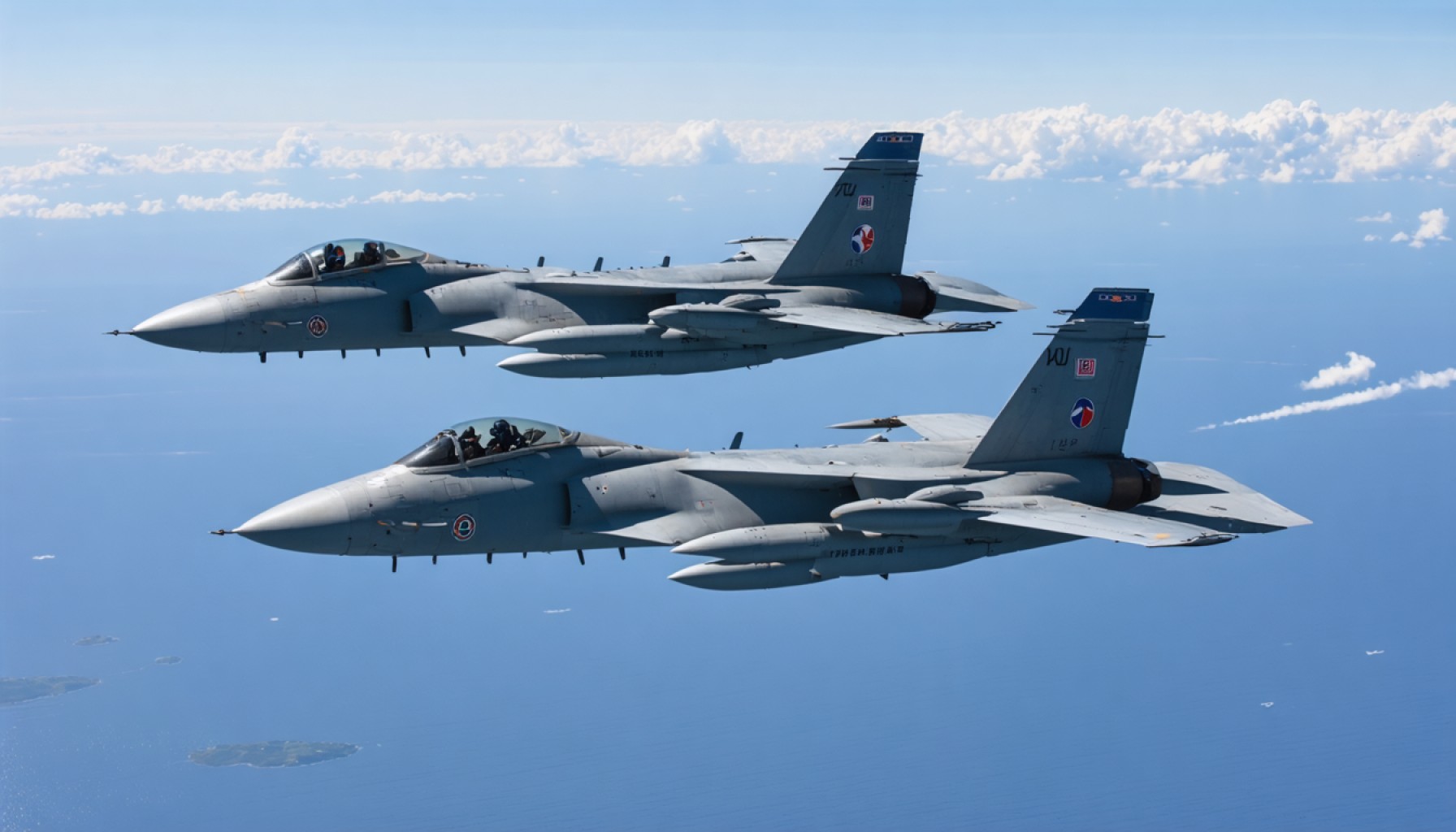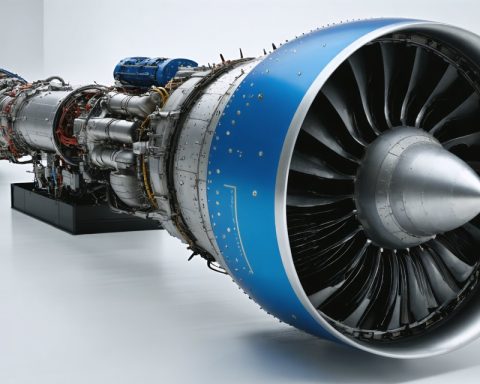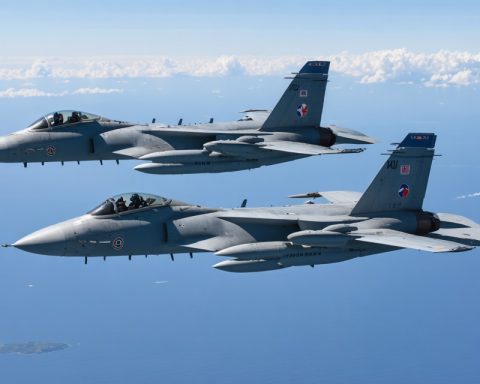- The U.S. and South Korea conducted a joint aerial drill, showcasing military readiness with advanced aircraft, including U.S. B-1B bombers and South Korean F-35s and F-15s.
- These exercises aim to deter North Korea’s nuclear ambitions and improve the integration of U.S. and South Korean forces.
- The frequency of joint maneuvers has increased due to rising regional security tensions.
- Advanced U.S. military assets play a critical role in these strategic exercises.
- North Korea continues to pose a threat with its growing nuclear arsenal, aligning with Russia and resisting denuclearization talks.
- International diplomatic efforts among the U.S., South Korea, and Japan focus on enhancing military cooperation and imposing sanctions on Pyongyang.
- The exercises symbolize unity and the ongoing pursuit of stability in a volatile region.
As dawn broke over the Korean Peninsula, an armada of military might took to the skies, cutting through the clouds with precision and power. In a stark display of military readiness, the U.S. and South Korean forces convened for their first joint aerial drill under President Trump’s second term. The roar of a U.S. B-1B bomber echoed across the region, accompanied by a formidable fleet of fighter jets—South Korea’s cutting-edge F-35s and F-15s stood shoulder to shoulder with American F-16s.
These exercises serve a dual purpose: reinforcing deterrence capabilities in the face of North Korea’s unyielding nuclear ambitions and refining the seamless integration of South Korean and U.S. forces. Recent years have seen an escalation in these joint maneuvers, reflecting the increasing volatility in regional security dynamics. Advanced U.S. military assets, including long-range bombers, aircraft carriers, and submarines, now play a critical role in these collaborative sessions, escalating their strategic significance.
Amidst this backdrop of high tensions, North Korean leader Kim Jong Un continues to wield his growing nuclear arsenal like a sword over the peninsula, aligning with Russia and dismissing global calls for denuclearization talks. Meanwhile, international pressure mounts as diplomatic engagements among the U.S., South Korea, and Japan intensify, pledging enhanced military cooperation and tighter sanctions to deter Pyongyang.
In a world teetering on the brink of further conflict, these exercises underscore a compelling narrative: the relentless pursuit of stability and freedom in a region fraught with uncertainty. As the jets disappear into the horizon, they leave behind a resonant message of unity and resolve.
Unveiling Military Synergy: U.S. and South Korea’s Aerial Drills Amid Regional Tensions
How-To Steps & Life Hacks for Understanding Military Exercises
1. Clarify Objectives: Military drills often have multiple aims, such as testing readiness, improving interoperability, and sending strategic messages. Understanding these objectives can clarify why such exercises occur.
2. Track the Assets: Familiarize yourself with the types of military assets being used. For instance, South Korea’s F-35s are known for stealth capabilities, while the U.S.’s B-1B bombers are designed for long-range precision strikes.
3. Analyze Political Context: Consider the geopolitical landscape, including tensions with North Korea and alliances with the U.S., South Korea, and other nations like Japan. Recognizing these factors helps contextualize the exercises.
Real-World Use Cases
Joint military exercises like those between the U.S. and South Korea are not unique; similar drills occur globally. These are used to:
– Enhance military cooperation and readiness.
– Provide hands-on training with advanced systems.
– Demonstrate defensive capabilities and deterrence.
Market Forecasts & Industry Trends
The defense sector is witnessing substantial growth, especially in aerial capabilities. A focus on stealth technology, unmanned aerial systems (UAS), and intelligence-gathering aircraft will continue scaling. Markets project the aerial defense sector to grow significantly by 2030, driven by innovations in AI and cyber-defense technologies Global Security.
Reviews & Comparisons
– F-35 vs. F-15: The F-35 offers advanced stealth and data fusion capabilities, surpassing the older F-15 in these areas, which focuses more on speed and payload.
– B-1B Bombers: Known for carrying large conventional payloads and offering a fast and flexible response.
Controversies & Limitations
Critics often question such military exercises’ costs and provoke tension. Environmental impacts and potential escalations into conflict are also concerns. Diplomatic channels occasionally view these as aggressive rather than preventive measures.
Features, Specs & Pricing
Understanding the hardware:
– F-35: Costs approximately $80 million per unit; praised for stealth and sensor fusion abilities.
– B-1B Lancer: Although no longer suitable for nuclear capabilities, it remains critical for long-range conventional missions.
Security & Sustainability
Security initiatives have focused on integrating cyber defenses to protect critical communications during exercises. However, the carbon footprint of such drills is substantial, necessitating plans to offset emissions.
Insights & Predictions
Expect increasing investment in unmanned systems and AI-enhanced machinery, designed to reduce the human risk factor in military operations. New collaborative drills could incorporate cyber and space warfare capacities.
Tutorials & Compatibility
Future training might include simulation-based drills that leverage augmented reality (AR) to simulate real-world scenarios, enhancing pilot skills without actual aircraft deployment.
Pros & Cons Overview
Pros:
– Strengthened military ties and operational synergy.
– Deterrent against adversarial actions.
Cons:
– High costs and environmental impact.
– Potential to inflame regional tensions.
Actionable Recommendations
– Stay Informed: Subscribe to defense-related updates for the latest in military strategies.
– Advocate for Sustainability: Support initiatives that reduce the environmental impact of such exercises.
– Encourage Dialogue: Promote diplomatic channels alongside military readiness to foster peace and understanding.
For a more in-depth exploration of defense strategies and global military balances, visit Global Security.








